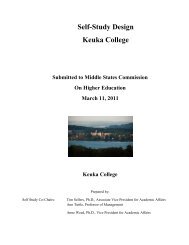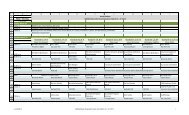final version of the self-study document - Keuka College's Middle ...
final version of the self-study document - Keuka College's Middle ...
final version of the self-study document - Keuka College's Middle ...
Create successful ePaper yourself
Turn your PDF publications into a flip-book with our unique Google optimized e-Paper software.
Chapter 3<br />
Leadership, Governance, and Administration<br />
Standard 4: Leadership and Governance<br />
The institution’s system <strong>of</strong> governance clearly defines <strong>the</strong> roles <strong>of</strong> institutional<br />
constituencies in policy development and decision-making. The governance structure<br />
includes an active governing body with sufficient autonomy to assure institutional<br />
integrity and to fulfill its responsibilities <strong>of</strong> policy and resource development, consistent<br />
with <strong>the</strong> mission <strong>of</strong> <strong>the</strong> institution.<br />
Standard 5: Administration<br />
The institution’s administrative structure and services facilitate learning and research/<br />
scholarship, foster quality improvement, and support <strong>the</strong> institution’s organization and<br />
governance.<br />
This chapter provides evidence <strong>of</strong> <strong>Keuka</strong> College’s compliance with Standard 4 and Standard 5.<br />
The leadership <strong>of</strong> <strong>the</strong> College is vested in <strong>the</strong> Board <strong>of</strong> Trustees, <strong>the</strong> President, and <strong>the</strong> Vice<br />
Presidents who comprise <strong>the</strong> Cabinet. These groups provide leadership in ensuring <strong>the</strong> College’s<br />
mission is implemented. <strong>Keuka</strong> College is operated through a system <strong>of</strong> shared governance.<br />
The constituencies involved in this system include <strong>the</strong> Board <strong>of</strong> Trustees, <strong>the</strong> President, <strong>the</strong><br />
Faculty, <strong>the</strong> President’s Cabinet (formerly known as <strong>the</strong> Administrative Team or informally as<br />
<strong>the</strong> A-Team), <strong>the</strong> Student Association <strong>of</strong> <strong>the</strong> College, and <strong>the</strong> recently established Staff Advisory<br />
Council (SAC) and College Advisory Council (CAC). Each has a formalized set <strong>of</strong> policies,<br />
procedures and/or By-Laws that clearly articulate <strong>the</strong>ir role in <strong>the</strong> governance <strong>of</strong> <strong>Keuka</strong> College.<br />
As <strong>the</strong> College has increased in complexity, particularly with regard to <strong>the</strong> scope and size <strong>of</strong> its<br />
academic programs, <strong>the</strong> Board has regularly assessed <strong>the</strong> effectiveness <strong>of</strong> <strong>the</strong> College’s<br />
administrative structure and institutional leadership. The Board recognizes <strong>the</strong> need for an agile<br />
and dynamic leadership team, and with <strong>the</strong> counsel <strong>of</strong> <strong>the</strong> College’s chief executive <strong>of</strong>ficer,<br />
accordingly approves new or restructured leadership positions that would allow greater<br />
effectiveness and efficiency. The major administrative changes since 2002, detailed below and<br />
discussed at length in Appendix 3.1 Major Administrative Changes, reflect <strong>the</strong> College’s growth<br />
in <strong>the</strong> non-traditional arenas, that is, <strong>the</strong> growth <strong>of</strong> <strong>the</strong> adult degree completion programs and <strong>the</strong><br />
overseas programs.<br />
At <strong>the</strong> Cabinet level, <strong>the</strong> President has recently reorganized institutional leadership in pr<strong>of</strong>ound<br />
ways. Major changes included integrating oversight and accountability for <strong>the</strong> Accelerated<br />
Studies for Adults Programs (ASAP) and support functions under <strong>the</strong> Vice President for<br />
Academic Affairs, and consolidating <strong>the</strong> enrollment management and marketing functions,<br />
previously divided between <strong>the</strong> traditional and ASAP programs, under one Vice President for<br />
Enrollment Management and International Relations. Implemented in August 2012, <strong>the</strong>se<br />
changes were <strong>the</strong> result <strong>of</strong> <strong>the</strong> President’s assessment <strong>of</strong> <strong>the</strong> enrollment and marketing functions<br />
and recognition that duplication <strong>of</strong> efforts could be reduced and recruitment streng<strong>the</strong>ned<br />
through integrated activities, such as recruiting transfer students for ei<strong>the</strong>r <strong>the</strong> traditional<br />
program or ASAP programs during college fairs at partner community colleges. The unification<br />
Page 1 <strong>of</strong> 19 Chapter 3: Leadership, Gov. & Admin.




